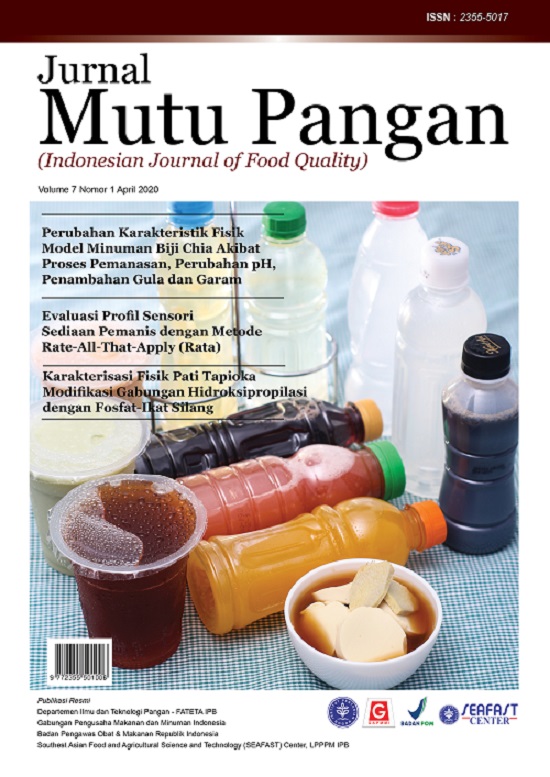Formulasi Campuran Bahan Pengemulsi untuk Bolu Sponge
Abstract
To make a sponge cake, a mix of emulsifiers provides an improved aeration. The aim of this research was to formulate the mix of distilled monoglycerides (DMG) and polyglycerol esters (PGE), which had yellowish color, in a gel form for its application in sponge cake. The formula of the gel consists of primary and secondary food additives: 15.3% DMG, 6.5% PGE, 25.8% other emulsifiers and carrier including colorings (ponceau and tartrazine), 26.1% sorbitol, and 26.3% water. DMG and PGE had different colors from their expected standard color, white. The formula of DMG (15.3%) and PGE (6.5%) mix, comprising 21.8% of the formula above, was re-formulated by 100:0, 75:25, 50:50, 25:75, and 0:100 ratios of DMG to PGE. The physical characteristics of the formula consisting of color characteristic by chromameter, sensory score by R-Index method and gel spreadability were compared to the formula using standard materials of DMG and PGE. The formula was then applied for sponge cake. The specific gravity of sponge cake batter, height of sponge cake after baking, as well as sensory characteristics of crumb structure and crumb color of sponge cake were analyzed. The results of physical characterization of formula revealed that the use of 100% of PGE and the use of DMG up to 50% did not significantly differ from the standard formula. The combination of DMG and PGE formula did not affect batter specific gravity, cake height and crumb structure, but affected color of the crumb.
Downloads
References
Bi J, O’Mahony M. 2007. Updated and extended table for testing the significance of the R-index. J Sensory Studies 22(6): 713-720. DOI: 10.1111/j. 1745-459X.2007.00132.x.
[BPOM] Badan Pengawas Obat dan Makanan. 2016. Peraturan Kepala Badan Pengawas Obat dan Makanan Republik Indonesia Nomor 8 Tahun 2016 Tentang Persyaratan Bahan Tambahan Pangan Campuran. Jakarta: BPOM.
Caballero B, Finglas PM, Toldra F (eds). 2016. Ency-clopedia of Foood and Health. Oxford (UK): Elsevier.
Chaiya B, Pongsawatmanit R. 2011. Quality of batter and sponge cake prepared from wheat-tapioca flour blends. Kasetsart J Nat Sci 45(2): 305-313.
Codex Committee on Food Additives. 2015. Dis-cussion Paper on Secondary Food Additives. Agenda item 8, CX/FA 15/47/19. Rome (Italy): Codex Alimentarius Commission. http://www.fao.org/tempref/codex/ Meetings/CCFA/ccfa47/fa47_19e.pdf (3 Juni 2020)
Fu Y, Zhao R, Zhang L, Bi Y, Zhang H, Chen G. 2018. Influence of acylglycerol emulsifier structure and composition on the function of shortening in layer cake. Food Chem 249: 213-221. DOI: 10.1016/j. foodchem.2017.12.051.
Jaekel T, Ternes W. 2009. Changes in rheological behaviour and functional properties of hen’s egg yolk induced by processing and fermentation with phospholipases. Int J Food Sci Technol 44(3): 567-573. DOI: 10.1111/j.1365-2621.2008.01847. x.
Kohajdova Z, Karovicova J, Schmidt S. 2009. Signi-ficance of emulsifiers and hydrocolloids in bakery industry. Acta Chimica Slovaca 2(1): 46-61.
Lee HS, Van Hout D. 2009. Quantification of sensory and food quality: the R-index analysis. J Food Sci 74(6): 57-64. DOI: 10.1111/j.1750-3841.2009.01 204.x.
Lee LY, Chin NL, Lim CH, Yusof YA, Talib RA. 2014. Saturated distilled monoglycerides variants in gel-form cake emulsifiers. Agriculture Agr-cultural Sci Proced 2: 191-198. DOI: 10.1016/j.aaspro.2014.11. 027.
Orthoefer F, Kim D. 2019. Applications of Emulsifiers in Baked Foods. In Emulsifiers and Their Appli-cations. Hasenhuettl GL, Hartel, RW (Eds). Spri-nger: Switzerland. Pp. 299-321. DOI: 10.10 07/ 978-3-030-29187-7_10.
Psimouli V, Oreopoulou V. 2013. The effect of fat replacers on batter and cake properties. J Food Sci 78(10): 1495-1502. DOI: 10.1111/1750-3841.12 235.
Richardson G, Langton M, Faldt P, Hermansson AM. 2002. Microstructure of α-crystalline emulsifiers and their influence on air incorporation in cake batter. J Cereal Chem 79(4): 546-552. DOI: 10.1094/CCHEM.2002.79.4.546.
Rhim J, Wu Y, Weller C, Schenpf M. 1999. Physical characteristics of a composite film of soy protein isolate and propyleneglycol alginate. J Food Sci 64(1): 149–152. DOI: 10.1111/j.1365-2621.1999. tb09880.x.
Sahi SS, Alava JM. 2003. Functionality of emulsifiers in sponge cake production. J Sci Food Agric 83: 1419-1429. DOI: 10.1002/jsfa.1557.
Sari DM, Andarwulan N, Fardiaz D. 2019. Profil komposisi BTP campuran, pelabelan, dan peng-gunaannya pada industri rumah tangga pangan (IRTP) di DKI Jakarta. J Mutu Pangan 6(1): 38-45. DOI: 10.29244/jmpi.2019.6.38.
Van de Walle D, Goossens P, Dewettinck K. 2008. Influence of sodium soap and ionic strength on the mesomorphic behavior and the a-gel stability of a commercial distilled monoglyceride. Food Res Int 41(3): 247-254. DOI: 10.1016/j.foodres.2007.12. 001.
Wrigley C, Corke H, Seetharaman K, Faubion J. 2016. Encyclopedia of Food Grains, 2nd Edition. Oxford (UK): Elsevier.
Yagiz Y, O Balaban M, Kristinsson HG, Welt BA, Marshall MR. 2009. Comparison of Minolta colo-rimeter and machine vision system inmeasuring colour of irradiated Atlantic salmon. J Sci Food Agric 89(4): 728-730. DOI: 10.1002/jsfa. 3467.
Zhou J, Faubion JM, Walker CE. 2011. Evaluation of different types of fats for use in high-ratio layer cakes. LWT-Food Sci Technol 44(8): 1802-1808. DOI: 10.1016/j.lwt.2011.03.013.

















